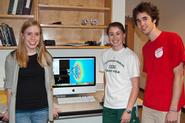
In 1918, the global influenza pandemic struck millions of families, killing a jaw-dropping three percent of the world’s population at the time. In the years that followed, scientists devised a treatment to stop the flu infection from spreading within the body. With the recent emergence of a particularly virulent strain of avian influenza, H5N1, near the beginning of the millennium and the rise of the highly transmissible but somewhat less virulent pandemic H1N1 “swine flu” in 2009, the concern that a repeat of this serious and lethal world health crisis could occur has escalated. The common drugs used for treatment of influenza are far from perfect, and they sometimes act in unexpected ways on the molecular level. Working with Assistant Professor of Chemistry Adam Van Wynsberghe, Erica Losito ’12 and Jeremy Adelman ’13 are taking a closer look at exactly what happens when the virus and the drug interact, in two different ways.
For a mature virus to release from an infected cell, it must cut the molecular ‘tether’ that holds it to the surface of the host cell. This tether is made up of cell surface receptors that end in a terminal sialic acid molecule. The virus uses a protein called neuraminidase that is able to bind to sialic acid and cut the tether. Only after this tether has been cut can the virus go on to infect additional host cells. Drugs such as peramivir and zanamivir bind to neuraminidase and inhibit the protein’s ability to bind to the sialic acids. Therefore the tether is left intact and the virus stays bound to the host cell, unable to continue on to infect other cells and giving the body time to mount an immune response.
In addition to the normal active site, there is a secondary site on the virus that can also bind to a host cell’s sialic acid. This secondary site cannot cut the tether, however, and scientists aren’t exactly sure what its purpose is. And when drugs bind there, scientists are even less certain of what happens. Figuring out just what this secondary site does could help scientists better understand how the flu virus works so they can better combat it.
Losito is running computer simulations to see how well the drugs bind to both sites. She uses Brownian dynamics simulations, a type of simulation that calculates the semi-random diffusion of particles. This type of motion was first observed by Scottish botanist Robert Brown, and later mathematically modeled by Einstein and Smoluchowksi. Brownian motion assumes that molecules will be randomly influenced by the fluctuations of their solvent, generating an infinite number of trajectories. As she simulates the binding to both the primary and secondary sites, Losito will calculate association rates, which indicate how fast the binding takes place at both sites.
But Brownian dynamics assume behaviors and movements of molecules that are not always true. Mostly, it assumes that molecules are rigid, which is a useful assumption when the molecules are far apart from each other; at close range, however, scientists must take into account that the individual atoms of the molecules move relative to each other. This summer, Adelman will use computer simulations of molecular dynamics to allow every single atom in the molecule to move, calculating more precise motions of the molecules when the binding event occurs. In Adelman’s simulation, molecules move every femtosecond (a femtosecond is one quadrillionth of a second, or one millionth of one billionth of a second). Although these calculations are numerical, simulations can take days to be completed. But, after setting up the conditions for the reaction, Adelman’s models could reveal very specific and accurate data about microscopic movements that could be extremely significant in the study of the influenza virus.
Losito and Adelman's summer research was funded through the Edward and Virginia Taylor Fund for Student/Faculty Research in Chemistry, established in 2008 through a gift from Ted ’46 and Virginia to inspire students interested in chemical research and to facilitate their work with outstanding faculty.
A rising junior, Losito plans to get into medicine after she graduates from Hamilton. She has already had several internships in the field, shadowing a pediatrician and volunteering at a hospital. She plans to pursue her interest in the medical field when she studies abroad in spring 2011 in Denmark, a country that has universal healthcare coverage.
Adelman is a rising sophomore who plans to focus all of his academic energies on sciences during his time in college. Outside of class, he enjoys cooking and English, Scottish and American country dancing. He says he likes all varieties of music, “except for contemporary country and Gregorian chants.”
Erica Losito '12 is a graduate of Fayetteville-Manlius High School (N.Y.) and Jeremy Adelman '13 graduated from Abington Heights High School (Pa.)
Posted June 21, 2010
